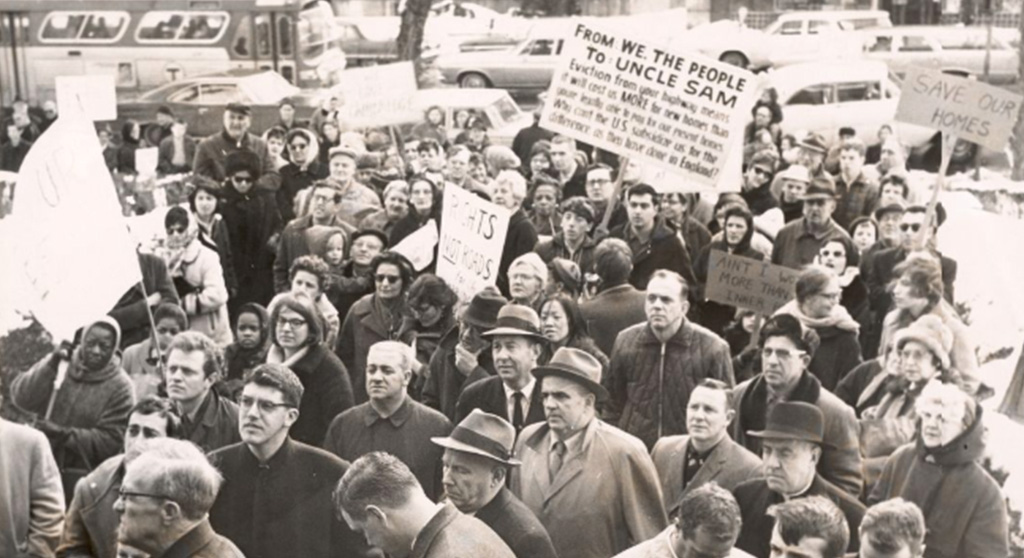A giant coalition that came together in the 1960s defeated a bigger threat: the ‘Inner Belt’ highway

Inner Belt marchers in the 1960s. (Photo: Historical Commission)
The Inner Belt was a proposed eight-lane highway that would have connected interstate U.S. routes 93 and 90 to Interstate 95 through a ring road through Somerville and Central Square and across the Boston University Bridge and beyond, through Boston to the Southeast Expressway. A group of city planners, community activists, universities and politicians formed a coalition to block construction.
Citizens organized a sit-in in 1966 to gain an audience with Massachusetts Institute of Technology president Howard Johnson; the next year, activists went to Washington, D.C., to meet with Massachusetts elected officials Tip O’Neill, Ed Brooke and Ted Kennedy. Protesters continued their marches with the rallying cry, “Cambridge is a city, not a highway!” In a particularly effective move, in 1968 Mayor Barbara Ackermann rode a horse up Brookline Avenue dressed as Paul Revere, urging people to make their voices heard at a demonstration at the State House.
The combined efforts of hundreds of activists preserved much of Cambridge and attracted national attention. As one of the earliest community endeavors to successfully block an infrastructure development, it became a rallying cry for many later political movements in Cambridge. You can read more about the history of the Inner Belt on the History Cambridge website.
Neighbor, historian and traffic engineer Steve Kaiser organized a conference this year that featured many of the key players who stopped the Inner Belt highway. A video of the conference shows what groups that band together, persevere and work imaginatively can accomplish. It includes former Gov. Michael Dukakis, MIT planning officer Bob Simha, Boston Transportation Planning Review project manager and mediator Jack Wofford, resident activists Anstis Benfield and myself and former state secretary of transportation Fred Salvucci.
The Inner Belt Committee continues to gather voices and memories from people who participated in the protests in the 1960s. Were you there? What do you remember from those times? What is the legacy from this activism? Please share thoughts and reactions at [email protected].
And don’t forget that 55 years ago the people of Cambridge rallied to defeat a highway that would have torn our city apart.
![]()
About History Cambridge
 History Cambridge started in 1905 as the Cambridge Historical Society. Today we have a new name, a new look and a whole new mission.
History Cambridge started in 1905 as the Cambridge Historical Society. Today we have a new name, a new look and a whole new mission.
We engage with our city to explore how the past influences the present to shape a better future. We strive to be the most relevant and responsive historical voice in Cambridge. We do that by recognizing that every person in our city knows something about Cambridge’s history, and their knowledge matters. We support people in sharing history with each other – and weaving their knowledge together – by offering them the floor, the mic, the platform. We shed light where historical perspectives are needed. We listen to our community. We live by the ideal that history belongs to everyone.
Our theme for 2022 is “How Does Cambridge Work?” Make history with us at cambridgehistory.org.
Rebecca Hall participated in the Inner Belt protests and is a member of the Inner Belt Committee.




